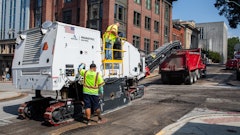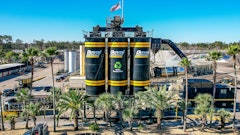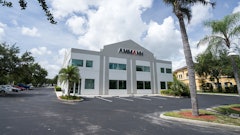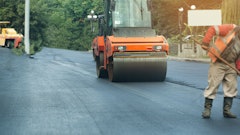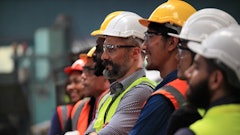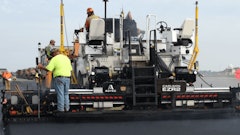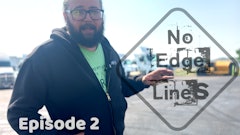
Much of the undercarriage-related owning and operating costs for pavers and milling machines are driven by your maintenance practices. As with most tracked equipment, a little attention goes a long way.
Track tension is perhaps the largest cost driver. Adjustment naturally gets looser with wear. "Most of your wear comes from internal pin and bushing wear, which you really can't see," says Rob Hannan, segment manager for milling products at Volvo. "That makes the track chain a little bit longer, so you have to take up the slack. If there are 30 pins and bushings and you take .5mm wear on each pin, it would be 15mm, which is over half an inch."
While periodic adjustment of track tension is needed, improper adjustment can do more harm than good. "Excessive track tension can cause excessive wear not only on the track components, but also on the drive system as the track will be more difficult to operate," says Dennis Clausen, director of training, GOMACO Corp.
"Over-tightening is always wrong," agrees Guido Bottin, vice president of operations, Berco. "It leads to accelerated wear of the components (pins, bushings and sprockets) and can cause breakages, especially in the steel chains. On the other side, running with a loose undercarriage may lead to detracking of the chains with possible damage to the system."
Advice for managing tension
Every manufacturer recommends checking track tension more or less frequently according to the load conditions, Bottin notes. For new machines with bolt-on shoes (steel only or rubberized), Berco recommends checking both tension and tightness of the bolt after the first 50 hours for heavy-duty use, or after the first 100 hours for moderate to light-duty use. "Additional checks should occur every other 200 to 250 additional hours of usage," he adds.
More frequent track tension checks may be required for pavers due to the heavy loads they can carry. "The operating weight on pavers changes dramatically when the machine is loaded - up to double compared to the unloaded condition," says Bottin. "If not properly tensioned, slippages of the undercarriage are possible and have to be avoided."
GOMACO Corp. recommends checking tension weekly on its larger pavers. (Smaller models have automatic tensioning.) "If the track is too tight, excessive wear will occur on the components. If the track is too loose, it is possible to ?walk' out of the track in a turn," Clausen explains. "Items that will affect tension are the type of material the track is running on (e.g., loose sand vs. a hard surface) and if concrete is allowed to get into the track."
For its milling machines, Volvo advises checking track tension every 50 hours to minimize potential problems. "With the style of sprocket most milling machines run, if you run it too loose, the sprocket tries to climb on top of the bushing, then it fires off the sprocket," says Hannan. "When it comes off, it sounds like a shotgun going off. It throws a real strain on your planetary and other track components.
"If you run the tension way too tight," he continues, "then it takes a lot more hydraulic pressure to turn the track. You can get them tight enough that the machine will not move. We have seen where they were running extremely high hydraulic pressures. We backed the track tension off and everything calmed down."
Also inspect other wear items on a regular basis. "The idler and sprockets do need to be inspected periodically," says Clausen. "Check with the component manufacturer for acceptable wear amounts. The hardware attaching the drive sprocket to the drive needs to be checked for proper torque at proper intervals." Refer to the machine service manual for specific recommendations.
Cleanliness is key
Cleaning tops the list when it comes to paver maintenance. "A buildup of hardened concrete can cause excessive wear on components and make servicing difficult. This includes the tracks," says Clausen. "On concrete paving equipment, the tracks should be cleaned as soon as possible."
Cleanliness is also important to keep milling machines in proper working condition. "The keys to a milling machine are keeping it clean - because you are working in a product that has sand in it - and keeping proper track tension," says Hannan. "The same goes for the rubber tracks on the pavers."
Rubber components can be sensitive to petroleum products. "Keep fuel away from the tracks and bogey tires," Hannan advises. Also be careful with cleaning agents. "Some caution has to be taken in choosing the proper detergents. Some solvents have been known to cause problems of aging to the rubber with significant reduction of the expected life."
Coatings are available to protect rubber tracks and components from fuel, tar and other contaminants. "We offer a product called Blaw Kote," Hannan notes. "You spray your tracks down with that and it keeps material from building up or sticking to the track."
Replacement tips
There are many indications that it's time to replace undercarriage components. "If no breakages are visible, excessive wear on the links, rails, bushings and pins (extended pitch beyond tolerance) are all good signs that the chain has to be replaced," says Bottin.
Berco advises always replacing the sprockets when a new set of chains is installed. "Sprocket teeth are critical to provide the torque necessary for motion through proper engagement with the chains or belts. Excessive wear may lead to slippage, popping and/or disengagement of the bushings," says Bottin. "Excessive wear on sprockets also leads to poor life and even damage due to extended pitch out of the bushings."
Idler life is a different story. "Life of the idlers is not necessarily related to the life of the chains/sprockets. Therefore, they can be used longer," says Bottin. "Idlers offered by Berco are lubricated for life; therefore, the only concern is with the wear on the rails. According to the models and the dimensions, there are wear limits that have to be respected and that have to be periodically checked."
A key indicator that the track needs to be replaced soon is if you are near the end of your idler adjustment, says Hannan. "Your idler can only move out so far to take up the adjustment," he points out.
Volvo suggests performing a thorough inspection to determine why you are replacing the track. "If you are replacing the track because there is a lot of internal pin wear and the exterior side of the bushing wear is minimal, chances are the sprocket can be run again," says Hannan. "Most of the wear associated with your sprocket is going to be in the root and the very bottom of the tooth, not on the tooth tip.
"Most manufacturers should be able to supply you with a gauge and measurements to measure your idler tread depth and roller overall diameter," he adds. "They usually make a gauge for the sprocket, as well."
"It's possible that the sprockets and idlers may last through more than one set of tracks," Clausen comments. "Pavers, for the most part, are slow moving machines (normally 20 fpm or less). Therefore, the wear factor is less.
"Track rollers are probably the most common failure point," he continues. "If a seal were to fail, the oil leaks out and the bearings fail."
A tremendous amount of side load is placed on track rollers during hard turns. This results in track rollers being replaced after the oil has leaked out. "We have gone to special oils and a tapered roller bearing in our track rollers, so we are hoping to cut down on that," says Hannan.
While some manufacturers still offer non-lubricated steel tracks, you can save more in the long run by using sealed and lubricated versions. "The greased and sealed is the best way to go," says Hannan. "The sealed and lubricated track chains should increase the life and cut down on the operational cost. The additional cost is minute by comparison."











